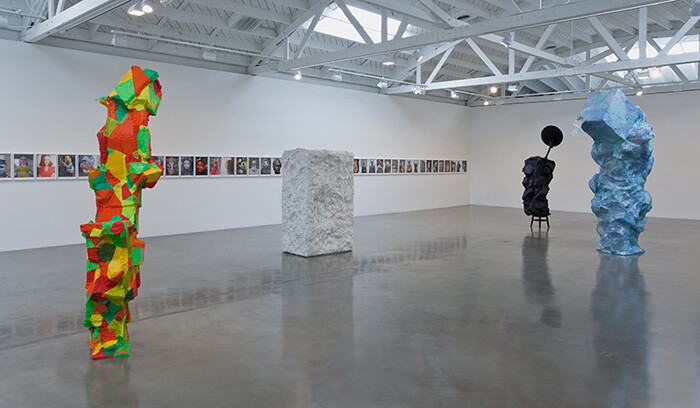Everything lilts and tilts in Rachel Harrison’s upright totems. Boxy facets jut out at every angle and swollen protrusions bulge all over the rough, peaked, and slathered stucco-like surfaces. Her piecemeal monoliths totter drunkenly in a barely-balanced equilibrium of unstable, crudely Cubistic passages. Their scale and verticality loosely suggest the figure: short, stocky ones and tall, skinny dancing ones. The five new sculptures at Regen Projects II appear like characters with increasingly distinct personalities when considered against the continuous frieze (spanning the far wall of the gallery) of fifty-one photographs of various masks, portrait busts, figurines, and dolls that constitutes the third and most recent installment of Harrison’s Voyage of the Beagle, Three (2008-2010). (The title is taken from Darwin’s eponymous study, implying a cataloguing of visual culture).
The artist’s sometime habit of naming her constructions with famous proper names—as she does here with one brightly hued, amped up and coked out Pablo Escobar patterned like a tropical harlequin and hung with a matching cluster of glossy yellow, red, orange, and green fake chilies—further invites an anthropomorphizing projection of personality onto dumb and mute material heft. A simulated cartoon humanity convulses the sculptures’ bulky forms.
As a group, they are an absurd, unlikely bunch. Around the Water Cooler (2010), an opalescent white block with an uneven, whipped cement surface ensconcing a Whirlpool Energy Star water cooler in a central cavernous niche, locates the group in space like a hub. It suggests the white cube as a Flintstones’ office set. Structural Design, a squat tower of two irregular boxes painted in an 80s neo-expressionist patchwork serves as the mutant pedestal for a Royal Safari portable typewriter whose blue plastic case has been shoved under one corner of the tower, tipping it off-kilter.
The typewriter proves to be the key to the show’s title, “Asdfjkl;” which codes the standard finger position of two hands on a keyboard into one ludicrous expletive. The title steers my muscle-memory into that suspended ready-set-go state that lingers before I formulate my response to her work into words—and in which the perplexing comedy her work elicits begins to open up fresh possibilities of exegesis. “Asdfjkl;” also pinpoints the contact between our bodies and those everyday things and machines that we interact with as both alien and corporeal extensions of ourselves, alerting us to home in on those tactile moments in her work when those glittering meteorites grasp or nestle some unexpectedly familiar found object.
As a general rule, Harrison’s sculptures work by punctuating large, often garishly colored, hand-made lumpen or angular abstract forms with a precisely selected but common found object made singular by its astounding recontextualization. That point of contact becomes the punctum, the fulcrum on which each piece pivots. Somehow, the sushi take out menu slapped on the head of Signature Roll (2010), for example, offsets that sculpture’s huge mass with its saccharine sweet iridescent turquoise and pink faux-rock (seemingly borrowed from the set of The Little Mermaid on Ice). Inexplicably, that flimsy, disposable piece of paper contains enough concentrated density of “the real” to counterbalance the piece’s ridiculously lumbering load. Harrison repeatedly points to the absurdity of sculpture, in all its awkward contortions and flashy flailing, which ultimately achieves its true affective potency when pricked by the disjunctive presence of a small rogue satellite launched from our collective vocabulary of pop culture and lived experience.



